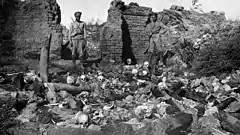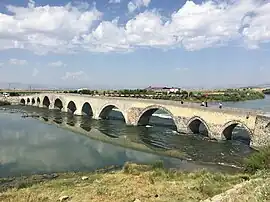Muş
Muş (pronounced [muʃ]; Armenian: Մուշ; Kurdish: Mûş)[2] is a city in eastern Turkey. It is the seat of Muş Province and Muş District.[3] Its population is 120,699 (2022).[1] Almost all of its population consists of Kurds.[4][5]
Muş
Մուշ | |
|---|---|
 | |
 Logo | |
 Muş Location in Turkey | |
| Coordinates: 38°44′00″N 41°29′28″E | |
| Country | Turkey |
| Province | Muş |
| District | Muş |
| Government | |
| • Mayor | Feyat Asya (AKP) |
| Elevation | 1,350 m (4,430 ft) |
| Population (2022)[1] | 120,699 |
| Time zone | TRT (UTC+3) |
| Postal code | 49000 |
| Area code | 0436 |
| Website | www |
Etymology
Various explanations of the origin of Muş's name exist. Its name is sometimes associated with the Armenian word mshush (Armenian: մշուշ), meaning fog, explained by the fact that the town and the surrounding plain are frequently covered in fog in the mornings.[6] The 17th-century explorer Evliya Çelebi relates a myth where a giant mouse created by Nemrud (Nimrod) destroys the city and its inhabitants, after which the city was named Muş (muš means "mouse" in Persian).[7] Others have proposed a connection with the names of different ancient Anatolian peoples, the Mushki or the Mysians, or the toponyms Mushki and Mushuni mentioned in Assyrian and Hittite sources, respectively.[7][8]
History

Ancient and medieval

The date of foundation of Mush is unknown, although a settlement is believed to have been around by the time of Menua, the king of Urartu (c. 800 BC), whose cuneiform inscription was found in the city's vicinity.[9] During the Middle Ages, Mush was the center of the Taron region of Armenia. It is first mentioned as a city in Armenian manuscripts of the 9th and 10th centuries. In the late 8th century Mush, along with the Taron region, came under control of the Armenian Bagratid (Bagratuni) dynasty, who reconquered it from the Arabs. Mush and the Taron region was captured and annexed to the Byzantine Empire in 969.[10]
After the 11th century, the town was ruled by Islamic dynasties such as the Ahlatshahs, Ayyubids, Ilkhanids and Kara Koyunlu. In the 10th-13th centuries Mush developed into a major city with an estimated population of 20 to 25 thousand people.[11] In 1387 the central Asian ruler Timur crossed the area and apparently captured Mush town without a battle.[12] Later the Akkoyunlu ruled the area and in the 16th the Ottomans took control over the town and region in the 16th century from the Persian Safavids. Mush remained part of the Ottoman Empire till the early 20th century and during these times retained a large Armenian population. In 1821 a Persian invasion reached Mush.[12]




Modern

British traveller H. F. B. Lynch travelled to Muş at the end of the 19th century. He described the city as "the most mis-governed town in the Ottoman Empire".[13]
At the turn of the twentieth century, the city had around 20,000 inhabitants, of which 11,000 were Muslims, while 9,000 were Christian Armenians.[14] According to the Catholic Encyclopedia (1913) the town had 27,000 inhabitants, of whom 13,300 were Muslims and 13,700 Armenians.[15] According to the Encyclopædia Britannica (1911) the population was nearly equally divided between Kurds and Armenians.[16]
During the Armenian genocide of 1915 the indigenous Armenian population of the region was exterminated.[17][18][19] Over 140,000 Armenians of the Mush sanjak (living in 234 villages and towns)[20] were targeted in June and July 1915.[21] Military-aged Armenian men were conscripted to serve in World War I. The Armenian population was largely defenseless to these threats.[22] The massacre of the Armenian population of the city of Mush came only after the surrounding villages were destroyed.[22]
The town was captured during by the forces of the Russian Empire in February 1916 during the World War I.[23] It was recaptur by Mustafa Kemal's Turkish Second Army in 1917.[24]
In the 1960s, the Arakelots Monastery was dynamited by Muş officials.[25]
Education
Alparslan University is one of the universities in Muş.
Tourism and main sights

The touristic places in Muş are the historical Murat Bridge, the tulips on the Muş plain, Muş Castle, Haspet Castle, Mercimekkale Mound, Lake Akdoğan, Künav Cave, Lake Haçlı, and Kayalıdere Castle.[26] The area of Muş has several ruined castles. Under the rule of medieval Armenian dynasties, monasteries and churches were built in localities near Mush, such as the Arakelots Monastery, Surp Marineh Church, and Surb Karapet Monastery, most of which are now ruins.
Under the rule of Muslim dynasties, other types of buildings were built as well. There are mosques from the Ottoman and pre-Ottoman period which show influences of Seljuk architecture, such as the Alaeddin Bey (18th century),[12] Haci Seref (17th century),[12] and Ulu (14th century, previously an Armenian church[27]) mosques.[12] Other sights include caravanserais like the Yıldızlı Han (13th century) destroyed in 1916, the now almost completely ruined Aslanlı Han,[12] the bathhouse and fountain of Alaeddin Bey, and tombs of Muslim saints.
Transportation
The city is served by the Muş Airport. It has a train station and a bus station.
Demographics
In the late 19th century, H. F. B. Lynch reports that the city of Muş had two large mosques with minarets, four Armenian Apostolic churches (Surb Marineh, Surb Kirakos, Surb Avetaranotz, and Surb Stepanos) and one Armenian Catholic church.[13]
Before the Armenian genocide, Armenians formed the majority of the population in the kaza of Muş. According to the Armenian Patriarchate of Constantinople, on the eve of the First World War, there were 75,623 Armenians, with 113 churches, 74 monasteries, and 87 schools.[13] They were all massacred during the Armenian genocide, many of them burned in their houses.[13] Almost all Muslims were Kurds.[13]
According to the 1927 Turkish census, the Muş District had 21,486 Muslims and 13 non-Muslims.[28]
| Turkish | Arabic | Kurdish | Circassian | Other |
|---|---|---|---|---|
| 5,921 | 61 | 14,839 | 570 | 108 |
Population of the municipality of Muş numbers 120,699 according to a 2022 estimate.[1] Kurds make up the majority of the population.[4][5] The rest are Arabs,[29] Crypto-Armenians,[30] Terekeme Turks and Circassians.
Gallery
 Muş Alaeddin Pasha Mosque
Muş Alaeddin Pasha Mosque Muş Alaeddin Pasha Mosque
Muş Alaeddin Pasha Mosque Muş Ulu Mosque
Muş Ulu Mosque Muş Ulu Mosque
Muş Ulu Mosque Muş Ulu Mosque
Muş Ulu Mosque Muş Hacı Şeref Mosque
Muş Hacı Şeref Mosque Muş Tuba Mosque
Muş Tuba Mosque Muş street scene
Muş street scene Muş street scene
Muş street scene Muş street scene
Muş street scene Old house in Muş
Old house in Muş Old house in Muş
Old house in Muş Muş Hospital
Muş Hospital Muş Castle
Muş Castle Muş Castle
Muş Castle View of Muş
View of Muş
Notable locals
- Armenak Shahmuradyan,[31] Armenian operatic tenor
- Zafer Çağlayan, Turkish politician and former Minister
- Sabahattin Oğlago, four-time Olympian cross-country skier
- Zeki Eker, Turkish politician of Kurdish origin
- Kürşat Duymuş, Turkish football defender
Climate
Muş has a humid continental climate (Köppen climate classification: Dsa, Trewartha climate classification: Dc) with cold, snowy winters and hot, very dry and very sunny summers.
| Climate data for Muş (1991–2020, extremes 1964–2022) | |||||||||||||
|---|---|---|---|---|---|---|---|---|---|---|---|---|---|
| Month | Jan | Feb | Mar | Apr | May | Jun | Jul | Aug | Sep | Oct | Nov | Dec | Year |
| Record high °C (°F) | 10.2 (50.4) |
15.0 (59.0) |
22.8 (73.0) |
30.0 (86.0) |
32.2 (90.0) |
37.4 (99.3) |
41.6 (106.9) |
41.2 (106.2) |
37.0 (98.6) |
30.6 (87.1) |
22.8 (73.0) |
16.0 (60.8) |
41.6 (106.9) |
| Average high °C (°F) | −2.8 (27.0) |
−0.7 (30.7) |
6.8 (44.2) |
15.4 (59.7) |
21.7 (71.1) |
28.3 (82.9) |
33.6 (92.5) |
33.9 (93.0) |
28.6 (83.5) |
20.5 (68.9) |
10.2 (50.4) |
1.0 (33.8) |
16.4 (61.5) |
| Daily mean °C (°F) | −6.5 (20.3) |
−4.9 (23.2) |
2.1 (35.8) |
9.8 (49.6) |
15.1 (59.2) |
20.8 (69.4) |
25.6 (78.1) |
25.7 (78.3) |
20.5 (68.9) |
13.4 (56.1) |
4.9 (40.8) |
−2.4 (27.7) |
10.3 (50.5) |
| Average low °C (°F) | −9.9 (14.2) |
−8.5 (16.7) |
−1.8 (28.8) |
4.9 (40.8) |
9.2 (48.6) |
13.4 (56.1) |
17.8 (64.0) |
17.9 (64.2) |
12.9 (55.2) |
7.6 (45.7) |
0.6 (33.1) |
−5.3 (22.5) |
4.9 (40.8) |
| Record low °C (°F) | −32.6 (−26.7) |
−34.4 (−29.9) |
−31.4 (−24.5) |
−10.2 (13.6) |
−2.4 (27.7) |
2.2 (36.0) |
3.6 (38.5) |
8.0 (46.4) |
0.0 (32.0) |
−3.0 (26.6) |
−25.8 (−14.4) |
−32.0 (−25.6) |
−34.4 (−29.9) |
| Average precipitation mm (inches) | 93.9 (3.70) |
106.0 (4.17) |
112.2 (4.42) |
102.1 (4.02) |
73.9 (2.91) |
28.5 (1.12) |
10.0 (0.39) |
4.8 (0.19) |
17.2 (0.68) |
59.7 (2.35) |
81.6 (3.21) |
92.0 (3.62) |
781.9 (30.78) |
| Average precipitation days | 12.47 | 11.70 | 13.90 | 15.27 | 15.30 | 6.77 | 2.43 | 1.80 | 3.53 | 9.80 | 8.53 | 11.37 | 112.9 |
| Mean monthly sunshine hours | 55.8 | 73.5 | 133.3 | 171.0 | 235.6 | 288.0 | 313.1 | 310.0 | 258.0 | 179.8 | 99.0 | 46.5 | 2,163.6 |
| Mean daily sunshine hours | 1.8 | 2.6 | 4.3 | 5.7 | 7.6 | 9.6 | 10.1 | 10.0 | 8.6 | 5.8 | 3.3 | 1.5 | 5.9 |
| Source: Turkish State Meteorological Service[32] | |||||||||||||
References
- "Address-based population registration system (ADNKS) results dated 31 December 2022, Favorite Reports" (XLS). TÜİK. Retrieved 22 May 2023.
- Adem Avcıkıran (2009). Kürtçe Anamnez Anamneza bi Kurmancî (in Turkish and Kurdish). p. 56.
- İl Belediyesi, Turkey Civil Administration Departments Inventory. Retrieved 22 May 2023.
- Saracoglu, Cenk (2010). Kurds of Modern Turkey: Migration, Neoliberalism and Exclusion in Turkish Society. I.B.Tauris. p. 194.
- Tas, Latif (2014). Legal Pluralism in Action: Dispute Resolution and the Kurdish Peace Committee. Ashgate Publishing. p. 33.
- Hakobyan, Tadevos Kh.; Melik-Bakhshyan, Stepan T.; Barseghyan, Hovhannes Kh. (1991). Հայաստանի և հարակից շրջանների տեղանունների բառարան [Dictionary of toponymy of Armenia and adjacent territories] (in Armenian). Vol. 3. Yerevan: Yerevan State University Press. p. 892.
- Petrosyan, Armen (2002), The Indo-European and Ancient Near Eastern Sources of the Armenian Epic, Washington, D.C: Institute for the Study of Man, pp. 140–142, ISBN 9780941694810.
- Hakobyan 1987, p. 198.
- Hakobyan 1987, p. 199.
- Thomas, David Richard (2001). Syrian Christians Under Islam: The First Thousand Years. BRILL. p. 160. ISBN 9789004120556.
- Hakobyan 1987, pp. -199-200.
- Sinclair, T.A. (1989). Eastern Turkey: An Architectural & Archaeological Survey, Volume I. Pindar Press. pp. 293–294–333–335. ISBN 9780907132325.
- "Kaza Muş / Մուշ – Mush". Virtual Genocide Memorial. Retrieved 2023-09-17.
- Hakobyan 1987, p. 200.
- Herbermann, Charles, ed. (1913). . Catholic Encyclopedia. New York: Robert Appleton Company.
- Chisholm, Hugh, ed. (1911). . Encyclopædia Britannica. Vol. 19 (11th ed.). Cambridge University Press.
- Walker, Christopher J. (1990) [1980]. Armenia: The Survival of a Nation (2nd ed.). New York: St. Martin's Press. pp. 211–212. ISBN 978-0-312-04230-1.
- Dadrian, Vahakn N.; Akçam, Taner (2011). Judgment At Istanbul: The Armenian Genocide Trials. Berghahn Books. p. 37. ISBN 9780857452863.
- Kévorkian 2011, pp. 339–345.
- Kévorkian 2011, p. 345.
- Kévorkian 2011, p. 339.
- Suny, Ronald G. (2015). "They Can Live in the Desert but Nowhere Else": A History of the Armenian Genocide. Princeton University Press. p. 289. ISBN 9781400865581.
- Tucker, Spencer C. (2013-12-16). The European Powers in the First World War: An Encyclopedia. Routledge. p. 175. ISBN 978-1-135-50694-0.
- Kramers, J. H. (1993). "Mūs̲h̲". In Bosworth, C. E.; Pellat, Ch.; Van Donzel, E.; Heinrichs, W. P. (eds.). Encyclopaedia of Islam. Vol. VII (New ed.). Leiden: E. J. Brill.
{{cite encyclopedia}}: CS1 maint: date and year (link) - Maranci, Christina (2002). "The Art and Architecture of Baghesh/Bitlis and Taron/Mush". In Richard G. Hovannisian (ed.). Armenian Baghesh/Bitlis and Taron/Mush. Costa Mesa, California: Mazda Press. pp. 120–122. ISBN 978-1-56859-136-0.
- "Muş GoTürkiye". Muş İl Kültür ve Turizm Müdürlüğü (in Turkish). Retrieved 2023-10-06.
- "Muş BasınMuş Basın / GEÇMİŞİN SİLİK İZLERİ". Memleket Havadis (in Turkish). Retrieved 2023-10-05.
- Van Gölü Havzası Sempozyumu Bitlis İli (Turkey) İstanbul Üniversitesi Avrasya Arkeoloji Enstitüsü. Yüzüncü Yıl Üniversitesi Atatürk Üniversitesi ÇEKÜL. Ii. Van Gölü Havzası Sempozyumu. 1. Basım ed. Van: Bitlis Valiliği İl Kültür ve Turizm Müdürlüğü; 2007. p. 280
- Gündoğdu, Raşit; Demir, Esra (11 April 2014). "The Arabs in Turkey". impr.org. International Middle East Peace Research Center. Archived from the original on 24 September 2015. Retrieved 7 March 2015.
- Gültekin, Uygar (23 September 2014). "Muş Ermenileri derneklerine kavuştu Paylaş". Agos (in Turkish).
- Hakobyan 1987, p. 203.
- "Resmi İstatistikler: İllerimize Ait Mevism Normalleri (1991–2020)" (in Turkish). Turkish State Meteorological Service. Retrieved 2 May 2021.
Sources and external links
- Bibliography
- Hakobyan, Tadevos (1987). "(Mush)". Պատմական Հայաստանի քաղաքները [Cities of historic Armenia] (in Armenian). Yerevan: "Hayastan" Publishing. pp. 196–203.
- Kévorkian, Raymond H. (2011). The Armenian Genocide: A Complete History. London: I. B. Tauris. ISBN 9781848855618.